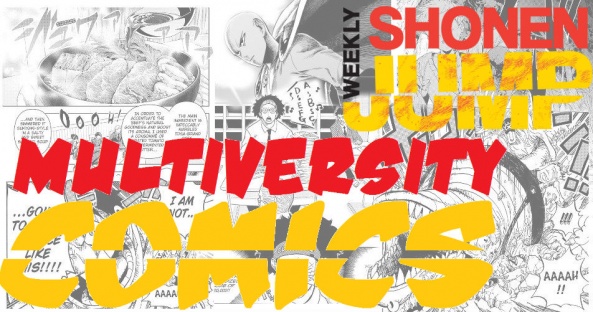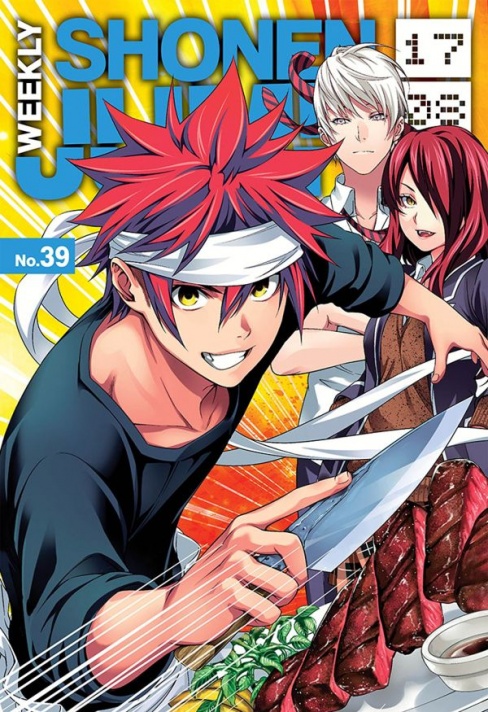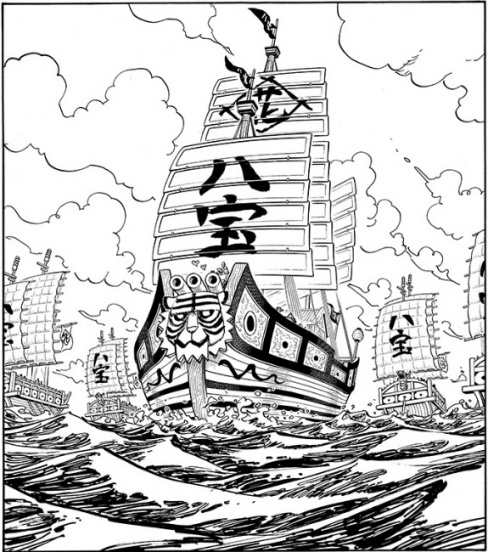
Welcome to This Week in Shonen Jump, in which a rotating duo of Multiversity staffers take a look at two stories contained in each installment of Viz Media’s Weekly Shonen Jump. For the uninitiated, Weekly Shonen Jump is an anthology that delivers more than 200 pages of manga of all varieties. We hope that you’ll join us in exploring the world of Weekly Shonen Jump each week. If you are unfamiliar, you can read sample chapters and subscribe at Viz.com.

This week, Zach and Vince check in with “One Punch Man” and “One Piece.” If you have any thoughts on these titles, or “Food Wars,” “Hunter x Hunter,” “Robot x Laserbeam,” “My Hero Academia,” “Black Clover,” “Dr. Stone,” “The Promised Neverland,” or “We Never Learn,” let us know in the comments!

One Piece – Chapter 876: Pudding Coincidentally Appears
Written and Illustrated by Eiichiro Oda
Review by Vince J Ostrowski
“One Piece” is an incredibly versatile manga, but sometimes that versatility gives way to having to juggle too many things at once. I praised an earlier chapter in this arc for its small, inclusive scope. It was a flashback episode concerning an earlier time in Big Mom’s life, which was fairly self-contained and did an incredible job of defining her character. And in fact, this entire arc has been full of episodes that start small and grow larger and larger as the principal cast starts to get folded in and allowed to do more. For a while, this was as focused as “One Piece” had felt in a while, to me. That changed a little bit in this issue, which felt like it was paying lip-service to all the various plots the story had been juggling, but not accomplishing much with any of them, and in fact, making some of them unnecessarily stretched out. Let me explain:
We begin with the aftermath of the Zeus lightning attack on Big Mom, which left her at the bottom of a smoking crater. This provides a fantastic moment for Big Mom as a villainous threat, as she basically plows blindly through the earth, driven food-horny with lust for a delicious wedding cake. Basically, this resets the deck for our Straw Hat heroes – they need to stall for time and figure out a different way to stop her. But the stall for time feels a lot like a stall for plot padding. I guess one thing that Oda accomplishes is better establishing Pudding’s split personality. Many times over the course of this issue do the characters make it clear that there is a “bad” and a “good” Pudding that she oscillates back and forth between. What was once a fairly haphazard character gets shored up a little bit here, though no less of a conflict for our heroes. Aside from that, Oda is simply moving the pieces around the board. One example is Sanji determining that he will be the one to bake the cake to quell Mom’s madness (and even maybe make her faint?). But in order to accomplish this, they cannot merely decide that he’s found a solution and get him to baking, instead, Oda makes it so that Sanji needs to leave the team and sail away to an entirely different island to find his ingredients. Obviously, the next chapter or two could prove me wrong, but at this point, it just feels like another stall for time in a classic manga series that didn’t make it to Chapter 876 by being 100% exciting all the time. As far as the rest of the characters go, they themselves are mostly stalling for time (Luffy), or showing up for a page just to remind us they exist (Chopper & Brook).
Oda’s art is wonderful to look at. It doesn’t look like any other manga I’ve ever seen, with only the vaguest of influences that I can spot throughout. Oda can be a chameleon, drawing characters like Sanji with a traditional human design, whereas Luffy look alien at times and Big Mom looks like something out of The Beatles’ Yellow Submarine cartoon. But if this is a transitional issue of storytelling, that is also reflected in the art. There are some standout moments: the scene of Big Mom causing the earth to ripple around her like swirling fudge as she plows towards our heroes is a standout moment where the art is larger than life. Oda’s art always looks best when he uses big panels or full pages in this way. It’s just that the art doesn’t get a lot of opportunities to sing in this particular chapter. The next issue looks like it’s going to be a big one, though.
Continued belowFinal Verdict: 6.0 – Chapter 876 is not a “filler” issue, but it’s definitely a transitional episode in the series when compared to the events of the previous chapter versus what looks to be coming next. The chess pieces are moving around the board, with not much exciting happening within this particular chapter.

One-Punch Man Chapter #74.2
Written by One
Illustrated by Yusuke Murata
Reviewed by Zach Wilkerson
For months now, the concurrent martial arts tournament/monster invasion plot threads have dominated “One-Punch Man.” A sense of intense decompression, compounded by the slow release schedule, has taken a negative toll on what was among the finest of Weekly Shonen Jump. However, this chapter sees a convergence of both plots, along with a triumphant return of its lovable star.
One of the things that made “One-Punch Man” so noteworthy and enjoyable from the outset was its irreverent, tongue-in-cheek approach to its subject matter. The series was never afraid to make fun of modern conventions and tropes, even poking fun at itself at times. To a degree, the martial arts tournament has kept that aspect of the book alive. Conversely, the Monster Association arc, while certainly over the top, has felt deliberately more serious. With the plot threads beginning to converge in recent issues, “One-Punch Man” has taken a dark turn, rather devoid of levity. One can argue that even this “grim hopelessness” is still hyperbolic, and I’d be inclined to agree. However, the line between parody and authenticity has become blurred. Essentially, the book is in danger of losing what once made it unique.
This chapter exemplifies this shift, with the majority of the issue focusing on the hopeless futility of Suiryu’s struggle against the moisturized Goketsu. Suiryu, thoroughly beaten, hangs on to live by a thread, calls out for help, leading to a montage of major heroes facing his or her own struggle. As a long-time fan of “Dragon Ball,” this beat feels familiar. A b-tier hero, outclassed and on the brink of ruin, calls out for help. After a sufficient period of doubt, the lead protagonist, having been previously sidelined, makes a triumphant return at the final moment. I’ve been trained by “One-Punch Man” to expect the unexpected, though in this case, the expected is exactly what is delivered.
Now, it’s certainly within reason that this inevitable turn of events will be used in turn to undermine common tropes and circumvent convention in a clever way. However, self-seriousness that has slowly crept into the series in recent months is still very much at play as Saitama makes his dramatic re-entry, with only the driest hint of satire within Saitama’s dialogue.
Qualms with the direction of the plot aside, Yusuke Murata’s art, as always, is an absolute treat. Even when “One-Punch Man” enters into standard super-hero fare, it’s one of the finest looking in its class. Murata’s depiction of the grotesque, both in Goketsu’s beastly form and Suiryu’s disfigured form, lends a sense of dread and urgency to the proceedings. Conversely, his dynamic depiction of Saitama’s heroic return is exhilarating.
With the potential end of this arc in sight, it remains to be seen just what kind of book “One-Punch Man” is positioning itself as. With a tightened focus on the struggle between heroes and villains, along with ever increasing stakes, the series feels more and more like the series it once aped. While it nevertheless remains quite enjoyable, it would be a shame to lose that cornerstone of sardonic wit.
Final Verdict: 7.0 – “One-Punch Man” is still a treat, though its trend towards mimicking the series it once parodied steals some its joy.






